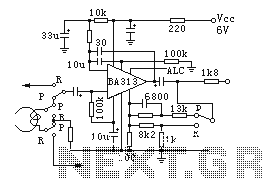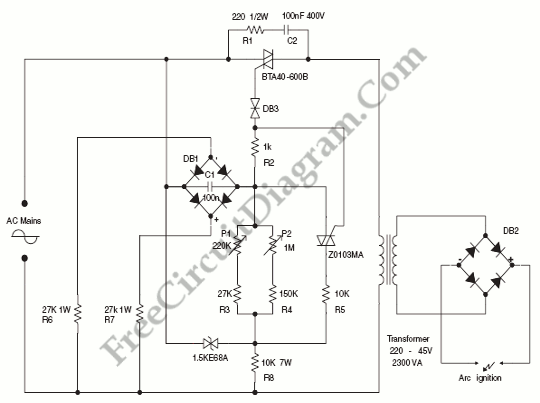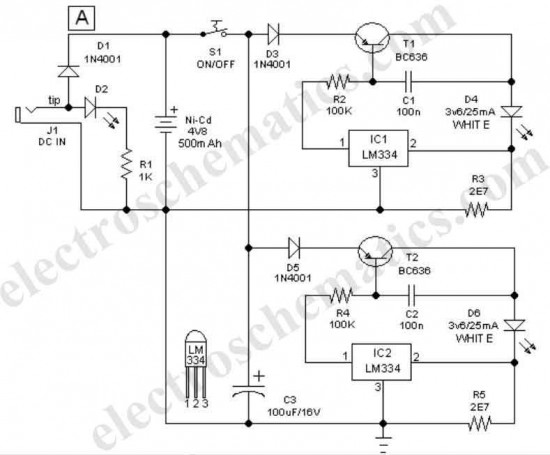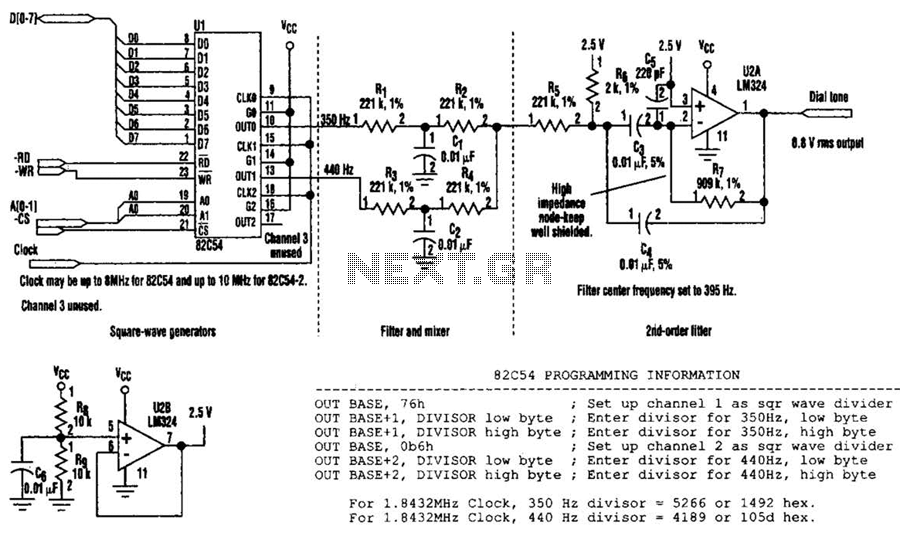
BA313 with ALC circuit diagram of sound recording

BA313 is a built-in automatic level control (ALC) circuit for audio recording preamplifiers, commonly used in cassette tape recorders. It is housed in a 9-pin dual in-line package (DIP) and features a wide range of automatic level control, operates within a wide voltage range (3-12V), and provides high gain with low distortion and low noise.
The BA313 circuit serves as an essential component in audio recording systems, particularly in cassette tape recorders, where maintaining consistent audio levels is crucial for high-quality sound reproduction. The automatic level control function adjusts the gain of the preamplifier in real-time, ensuring that the audio signal remains within an optimal range, thus preventing clipping during loud passages and enhancing the overall audio fidelity.
The design of the BA313 allows it to operate efficiently across a supply voltage range of 3V to 12V, making it versatile for various applications. The 9-pin DIP format facilitates easy integration into existing circuit designs, promoting compactness and ease of assembly.
Key specifications include a high gain characteristic, which amplifies weak audio signals to usable levels without introducing significant distortion. The circuit's low distortion and low noise attributes are critical for maintaining the integrity of the audio signal, ensuring that the recorded output is clear and faithful to the original sound source.
In practical applications, the BA313 can be utilized in conjunction with other audio processing components, such as equalizers and mixers, to create a comprehensive audio system. The combination of its automatic level control feature, operational voltage flexibility, and superior audio performance makes the BA313 a valuable asset in the design of high-quality audio recording equipment.BA313 is a built-in automatic level .png">control circuit (ALC) of audio recording preamplifier circuit, commonly used in the cassette tape recorder, 9-pin DIP dual in-line package, the circuit has the following characteristics: a wide range of automatic level control, operating voltage wide range (3-12V), high gain, low distortion, low noise.
The BA313 circuit serves as an essential component in audio recording systems, particularly in cassette tape recorders, where maintaining consistent audio levels is crucial for high-quality sound reproduction. The automatic level control function adjusts the gain of the preamplifier in real-time, ensuring that the audio signal remains within an optimal range, thus preventing clipping during loud passages and enhancing the overall audio fidelity.
The design of the BA313 allows it to operate efficiently across a supply voltage range of 3V to 12V, making it versatile for various applications. The 9-pin DIP format facilitates easy integration into existing circuit designs, promoting compactness and ease of assembly.
Key specifications include a high gain characteristic, which amplifies weak audio signals to usable levels without introducing significant distortion. The circuit's low distortion and low noise attributes are critical for maintaining the integrity of the audio signal, ensuring that the recorded output is clear and faithful to the original sound source.
In practical applications, the BA313 can be utilized in conjunction with other audio processing components, such as equalizers and mixers, to create a comprehensive audio system. The combination of its automatic level control feature, operational voltage flexibility, and superior audio performance makes the BA313 a valuable asset in the design of high-quality audio recording equipment.BA313 is a built-in automatic level .png">control circuit (ALC) of audio recording preamplifier circuit, commonly used in the cassette tape recorder, 9-pin DIP dual in-line package, the circuit has the following characteristics: a wide range of automatic level control, operating voltage wide range (3-12V), high gain, low distortion, low noise.





